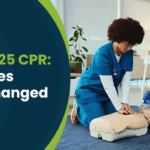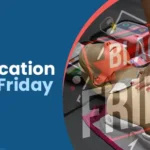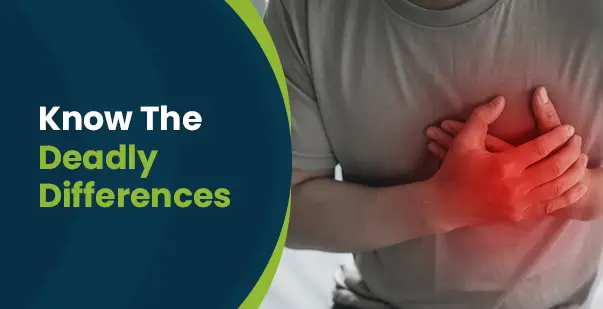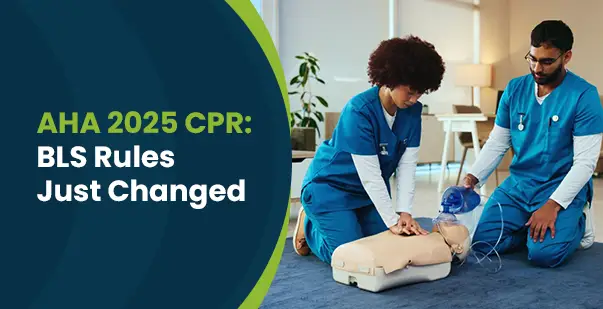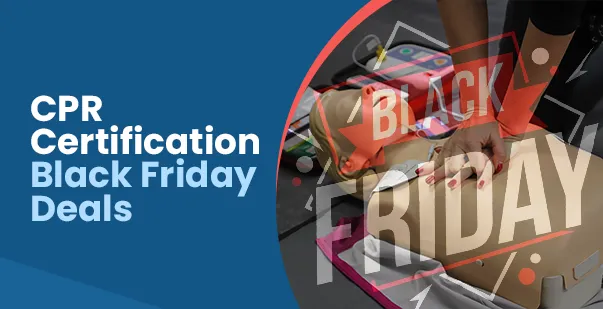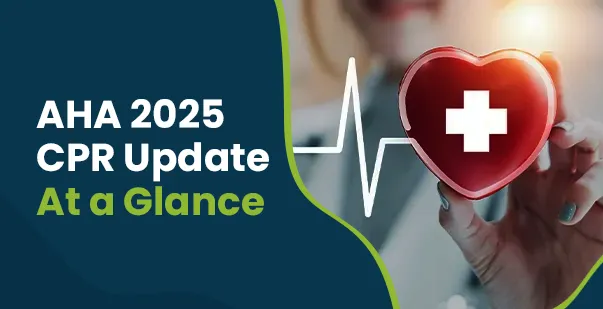Do you know that for every 40 seconds, someone in the United States has a stroke, while simultaneously, heart attacks claim countless lives? This statistic from the Centers for Disease Control and Prevention (CDC) reveals a startling reality: many Americans, even your friend/colleague, or family member, face these life-threatening cardiac emergencies daily. Yet most people cannot distinguish between a stroke and a heart attack when it matters most. Would you know which symptoms to watch for if your loved one suddenly collapsed? Both conditions strike suddenly and demand immediate action. Read on to learn how their symptoms, causes, and treatments differ dramatically.
What is a Heart Attack?
A heart attack occurs when blood flow to your heart muscle becomes blocked. This medical emergency happens primarily due to coronary artery disease. When a heart attack causes the heart to stop beating effectively (cardiac arrest), CPR manually pumps blood to keep oxygen flowing to the brain and vital organs. This buys critical time until emergency medical help arrives with a defibrillator and advanced treatments.
How Heart Attacks Develop?
Your heart muscle requires a constant oxygen supply through the coronary arteries. When these arteries become blocked by blood clots or plaque buildup, heart tissue begins dying. Coronary arteries narrow gradually over time. The blockage prevents oxygen-rich blood from reaching the heart muscle. Moreover, the sudden rupture of these plaques triggers blood clot formation. Without immediate intervention, permanent heart damage occurs.
What is a Stroke?
In 2022, 1 in 6 deaths (17.5%) from cardiovascular disease were due to stroke, according to the CDC. Strokes affect your brain rather than your heart. This condition occurs when the blood supply to the brain tissue is interrupted or reduced. And with every passing minute, more brain cells die permanently, taking with them memories, speech, movement, or other functions.
It’s like your phone suddenly losing power in the middle of something important; the moment the battery dies, everything stops working. But worse, the longer it stays dead, the more you risk losing: unsaved photos, messages, work.
How Does a Stroke Develop?
There are two main stroke types that exist with different mechanisms. Ischemic strokes result from blocked brain arteries. Hemorrhagic strokes involve bleeding in the brain. Both types damage brain cells rapidly without oxygen.
Brain cells require a continuous oxygen supply. Blocked or ruptured blood vessels interrupt this delivery. Brain tissue begins dying within minutes of oxygen deprivation. Different brain areas control specific body functions. Stroke location determines which abilities are affected. For example, a stroke in the left side of your brain may cause weakness or paralysis on the right side of your body and affect your ability to speak or understand language. A stroke in the back of your brain (occipital lobe) can impair your vision,
Is Stroke a Heart Attack?
Many people ask if a stroke is a heart attack because both involve the cardiovascular system. However, these conditions affect completely different organs. Heart attacks target the cardiac muscle. Strokes damage brain tissue. So how do they differ?
- Heart attacks occur in the coronary circulation. Strokes happen in the cerebral circulation.
- Your heart pumps blood throughout your body. Your brain controls all body functions. Each organ requires different treatment approaches.
- Heart attacks fall under cardiac emergencies.
- Strokes belong to neurological emergencies. Emergency rooms handle each condition differently.
Here’s a brief overview of stroke vs heart attack:
| Aspect | Heart Attack | Stroke |
| Affected Organ | Heart muscle | Brain tissue |
| Blood Supply Issue | Coronary arteries | Cerebral arteries |
| Primary Cause | Blocked coronary artery | Blocked/ruptured brain vessel |
| Emergency Type | Cardiac | Neurological |
| Treatment Focus | Restore heart blood flow | Restore brain circulation |
Symptoms of Heart Attack vs Stroke
When a heart attack or stroke strikes, there’s no time for confusion. Therefore, you must know the difference between a Heart attack vs stroke. Here’s what you must recognize immediately:
Heart Attack Warning Signs
Chest discomfort remains the most common heart attack symptom. This pain often feels like a pressure, squeezing, or burning sensation. You might experience discomfort in your arms, back, neck, jaw, or stomach. Shortness of breath frequently accompanies chest pain.
Additional heart attack symptoms include:
- Cold sweats and nausea
- Lightheadedness or dizziness
- Fatigue lasting several days (more common in women and may not always present)
- Heartburn-like sensation
Stroke Warning Signs
Stroke symptoms typically affect one side of your body. Sudden face drooping on one side signals a potential stroke. Arm weakness or numbness indicates brain circulation problems. Speech difficulties include slurred words or confusion.
The FAST acronym helps remember stroke signs:
- Face drooping
- Arm weakness
- Speech difficulty
- Time to call 911
Gender-Specific Symptom Differences
Women may experience different heart attack symptoms than men. Female heart attack signs include jaw pain, nausea, and back pain. Men typically report classic chest pain symptoms. Stroke symptoms remain similar across genders. However, women may experience atypical stroke symptoms more frequently than men, such as severe headache, altered mental status, confusion, or generalized weakness.
Women also face unique risk periods during pregnancy and the postpartum period when stroke risk increases. If you’re a woman experiencing unusual symptoms, don’t dismiss them. Make sure to seek immediate medical attention, as these atypical presentations can delay diagnosis and treatment.
| Condition | Primary Symptoms | Secondary Symptoms |
| Heart Attack | Chest pain/pressure | Arm pain, shortness of breath, nausea |
| Stroke | Face drooping, arm weakness | Speech problems, sudden headache, vision loss |
Read More: Prodromal Symptoms: 6 Warning Signs of a Heart Attack or Stroke a Month Before
What Are the Causes of a Heart Attack?
A heart attack centers around blocked coronary arteries. Let us take a look at the causes to recognize your risk factors and take preventive measures:
Coronary Artery Disease
Coronary artery disease represents the leading heart attack. Atherosclerosis creates plaque buildup in artery walls. These deposits narrow the coronary arteries gradually. Sudden plaque rupture triggers blood clot formation.
Immediate Triggers
Several factors can trigger sudden heart attacks. Physical exertion increases the heart’s oxygen demand. Emotional stress raises blood pressure rapidly. Cold weather constricts blood vessels. Heavy meals divert blood flow from the heart.
Underlying Conditions
Diabetes damages blood vessels over time. High blood pressure weakens artery walls. High cholesterol accelerates plaque formation. Smoking reduces oxygen delivery to the heart muscle.
Spontaneous Coronary Artery Dissection (SCAD)
SCAD happens when a small tear forms in the wall of a heart artery. This creates a false channel inside the artery, which presses on the real blood flow path. As a result, the heart muscle may not get enough blood. It often causes chest pain similar to a heart attack. SCAD is seen most often in women under 50.
What Are The Major Causes of Stroke?
Stroke causes vary depending on the stroke type. Ischemic and hemorrhagic strokes have different underlying mechanisms. Here’s a brief overview of the causes of stroke,
Ischemic Stroke Causes
Blood clots cause most ischemic strokes. These clots form in brain arteries or travel from other body areas. Atrial fibrillation increases clot formation, and carotid artery stenosis blocks brain blood flow.
Hemorrhagic Stroke Causes
High blood pressure represents the primary hemorrhagic stroke. When left untreated, hypertension weakens blood vessel walls. Aneurysms create weak spots prone to rupture, while arteriovenous malformations increase bleeding risk.
Embolic Sources
Heart conditions can send clots to the brain arteries. Irregular heart rhythms promote clot formation. Heart valve problems create turbulent blood flow. Moreover, in rare cases, recent heart surgery increases embolic risk.
Hyper-Coagulable Disorders and Infective Emboli
Certain conditions, like antiphospholipid syndrome, factor V Leiden, cancer, or bacterial endocarditis, increase the risk of blood clots or infected particles forming. These clots or septic fragments can travel through the bloodstream and block arteries in the brain.
Risk Factors of Heart Attack vs Stroke
Both conditions share several risk factors while maintaining unique predisposing elements. When you know the difference between stroke and heart attack risk factors, you can follow the most appropriate prevention strategies.
Shared Risk Factors
Age increases the risk for both conditions significantly. High blood pressure damages both the heart and the blood vessels. Diabetes affects circulation throughout your body. Smoking accelerates vessel disease progression.
Heart Attack-Specific Risks
A family history of heart disease remains one of the strongest predictors of heart attack risk. Men face a higher risk earlier in life, largely due to hormonal and lifestyle factors. However, after menopause, women’s natural estrogen protection declines, and their risk rises sharply, eventually matching that of men.
Obesity adds strain to the heart, making it work harder to pump blood. Similarly, a sedentary lifestyle weakens cardiovascular fitness and increases the likelihood of hypertension, diabetes, and high cholesterol, all major contributors to heart attacks.
Stroke-Specific Risks
Previous strokes increase recurrence risk dramatically. Atrial fibrillation creates clot formation. Carotid artery disease blocks brain circulation. Certain medications also increase bleeding risk.
The key risks are summarized as follows:
| Risk Category | Heart Attack | Stroke |
| Age Factor | Men >45, Women >55 | Risk doubles every 10 years after 55 |
| Gender | Men are at higher risk | Equal risk after menopause |
| Specific Conditions | Family history, obesity | Atrial fibrillation, previous stroke |
| Lifestyle | Sedentary behavior | Excessive alcohol consumption |
How to Respond to a Heart Attack vs a Stroke (First Aid)
Emergency response differs significantly between these conditions. Knowing proper first aid techniques for stroke vs heart attack can save lives.
Heart Attack First Aid
A heart attack is a medical emergency; call 911 immediately. Do not attempt to drive the person to the hospital yourself. Early treatment can save a life.
Immediate Steps:
- Call 911 right away. Do not drive the person to the hospital.
- Keep the person calm and seated, preferably in a comfortable, upright position.
- Loosen tight clothing around the chest and neck to ease breathing.
- Give aspirin only if:
- The person is alert and conscious, and
- There are no allergies or prior warnings from their doctor.
- Have them chew and swallow 162–325 mg of non-enteric coated aspirin for a suspected heart attack (not stroke).
- If you’re unsure, wait for EMS before giving aspirin.
- Assist with nitroglycerin only if it’s prescribed specifically for that person.
- Monitor breathing and pulse. Be ready to begin CPR if the person becomes unresponsive.
Quick Reference: Do’s and Don’ts
| Do | Don’t |
| Call 911 immediately. It is the fastest route to emergency care. | Don’t drive the person to the hospital yourself. |
| Keep the person calm and seated upright. | Don’t lie them flat or make them walk around. |
| Give aspirin (162–325 mg) to an alert, non-allergic adult with chest pain. | Don’t give aspirin if stroke is suspected or if the person is unconscious. |
| Help with nitroglycerin only if it’s their prescribed medication. | Don’t give anyone else’s medicine, including nitroglycerin. |
| Prepare for CPR if breathing or pulse stops. | Don’t delay emergency calls to contact family first. |
Stroke First Aid
Stroke response requires different actions. Call 911 immediately for a suspected stroke, then notify family members. Note the time symptoms began; this information helps doctors choose treatments. Do not give food, water, or medications. Keep the person lying down with the head slightly elevated.
FAST response protocol:
- Face – Check for facial drooping
- Arms – Test arm strength
- Speech – Listen for slurred speech
- Time – Call 911 immediately
Never give water to stroke patients due to swallowing difficulties. Don’t give medications unless prescribed specifically. Avoid moving patients unnecessarily. Don’t waste time calling family before emergency services.
What is the Emergency Response Time Impact?
Quick emergency response dramatically improves outcomes for both conditions. The heart muscle begins dying within 20-30 minutes without oxygen. Every minute delay increases permanent damage. For a specific type of severe heart attack called STEMI, doctors measure the time from when you arrive at the hospital to when they open the blocked artery. This is called “door-to-balloon time.” Door-to-balloon time under 90 minutes improves survival rates significantly. Faster treatment helps save more heart muscle and leads to better recovery.
Brain tissue dies rapidly during strokes. “Time is brain” emphasizes treatment urgency. IV thrombolytic medications (clot-busting drugs) are typically given within 3 to 4.5 hours of symptom onset. Mechanical thrombectomy, a procedure to physically remove the clot, can extend the treatment window up to 24 hours in selected cases of large vessel occlusion, when imaging shows salvageable brain tissue.
When to Seek Medical Help?
Both conditions require immediate emergency medical attention. However, recognizing when to call 911 versus scheduling doctor visits helps ensure appropriate care. Here’s when you should seek professional support:
Emergency Situations
Call 911 immediately for chest pain lasting more than five minutes. A sudden, severe headache, unlike any previous experience, demands emergency care. One-sided weakness or numbness requires immediate attention. Speech difficulties or confusion also signal emergencies.
Warning Signs Requiring Immediate Care
Any combination of heart attack symptoms needs an emergency response. Sudden onset of neurological symptoms always requires immediate attention. Don’t wait to see if symptoms improve. Time equals heart muscle and brain tissue.
Pre-Hospital Care
Emergency medical services provide critical pre-hospital interventions. EMS rapidly assesses symptoms, triages patients, and pre-notifies designated stroke centers to prepare for immediate treatment upon arrival. The pre-notification by EMS allows the Hospital to prepare for immediate treatment. Ambulance transport provides continuous monitoring during transport. Hospital notification allows preparation for immediate treatment. Ambulance transport provides continuous monitoring during transport.
Strategies to Prevent Both Stroke and Heart Attack
Prevention remains the most effective approach against both conditions. The difference between heart attack and stroke prevention involves shared lifestyle modifications with condition-specific strategies. Let us take a look at some strategies to prevent the onset of these conditions:
Lifestyle Modifications
Regular physical activity strengthens the cardiovascular system significantly. Aim for 150 minutes of moderate exercise weekly. A healthy diet reduces multiple risk factors simultaneously. Mediterranean diet patterns show particular benefits.
Blood Pressure Management
Maintaining blood pressure below 130/80 mmHg reduces both stroke and heart attack risk. Regular monitoring helps detect hypertension early. Medication compliance prevents complications. Lifestyle changes complement medical treatment.
Cholesterol Control
While commonly recommended targets include keeping total cholesterol below 200 mg/dL and LDL cholesterol under 100 mg/dL, your specific goals should be determined by your healthcare provider based on factors like your age and medical history. Regular lipid panels monitor cholesterol levels. Statin medications provide additional protection when indicated.
Diabetes Management
Maintain hemoglobin A1c below 7% through diet, exercise, and medication. Regular blood sugar monitoring prevents complications. Apart from proper Diabetes education, ensure to opt for annual eye and kidney exams to detect early complications.
Smoking Cessation
Quit smoking to dramatically reduce both stroke and heart attack risk. Smoking cessation benefits begin immediately. Nicotine replacement therapy improves success rates. You can join support groups to get additional motivation and accountability.
Healthy Weight Management
Maintain a healthy body mass index between 18.5-24.9. Even a slight loss in your weight scale can help you prevent the risk of developing these conditions. The combination of diet and exercise works most effectively. You can also seek professional guidance to improve long-term success rates.
Regular Medical Care
Annual physical examinations detect risk factors early. Blood pressure checks should occur every two years minimum. Cholesterol screening every four to six years for most adults. Diabetes screening begins at age 35 for average-risk individuals, though earlier screening is needed if you are overweight or have a family history.
Medication Adherence
Take prescribed medications consistently as directed. Blood pressure medications prevent both conditions effectively. Cholesterol-lowering drugs reduce arterial blockages. Diabetes medications prevent vascular damage progression.
Stress Management
Chronic stress contributes to both heart attack and stroke risk. Practice regular stress reduction activities to promote your cardiovascular health. You can also engage in meditation, yoga, and deep breathing exercises to manage stress. Plus, ensure adequate and proper sleep to support overall cardiovascular health.
Read More: National Lipid Day: Managing Cholesterol for a Healthy Heart
Protect Yourself with Proper Knowledge!
A stroke vs a heart attack looks similar, but they have their own differences, which require you to respond effectively during medical emergencies. Heart attacks primarily affect the cardiac muscle through blocked coronary arteries. Chest pain, arm discomfort, and shortness of breath signal heart emergencies. However, strokes impact brain function via interrupted cerebral blood flow. Face drooping, arm weakness, and speech difficulties indicate brain emergencies. Prevention remains your strongest defense against both conditions. Regular exercise, a healthy diet, blood pressure control, and smoking cessation reduce risks dramatically.
Ready to become prepared for medical emergencies? Enroll in our comprehensive online first aid course today and learn life-saving CPR techniques, emergency recognition skills, and critical response protocols from the convenience of your home/ workspace.
